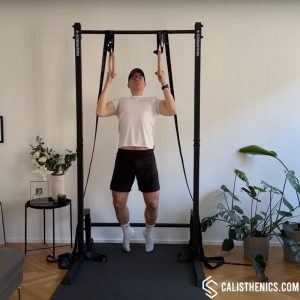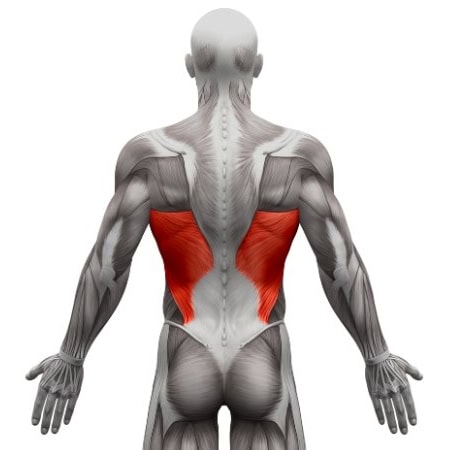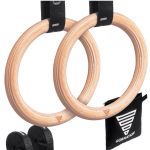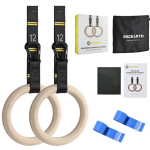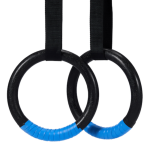Feet Assisted Ring Pull-up
How to do Feet Assisted Ring Pull-up?
The feet-assisted ring pull-up is a scalable pull-up progression that allows athletes to build pulling strength, endurance, and technique with reduced body weight. By keeping the feet on the ground or an elevated surface, the athlete can control the level of assistance, making it an ideal exercise for those working toward strict pull-ups, ring pull-ups, or muscle-ups. The instability of the rings also engages stabilizer muscles, making this an effective exercise for developing grip strength, scapular control, and upper-body endurance.
This exercise can be performed with different levels of assistance depending on the positioning of the feet:
• More assistance: Keeping feet flat on the ground.
• Less assistance: Using only the toes or placing feet on an elevated surface.
Steps to Perform a Proper Feet-Assisted Ring Pull-Up
1. Set Up the Rings
• Adjust the rings to a height where you can comfortably hold onto them while keeping your feet on the ground or a platform.
• Ensure the rings are securely anchored and allow for a full range of motion.
2. Grip the Rings in a Neutral or Supinated Position
• Hold the rings with palms facing each other (neutral grip) or palms facing you (supinated grip).
• Keep your wrists straight and grip firm.
3. Position Your Feet for Assistance
• Feet flat on the ground (most assistance).
• Toes on the ground (moderate assistance).
• Feet on an elevated surface (least assistance).
4. Engage Your Core and Scapula
• Tighten your core and glutes to keep your body stable and engaged.
• Depress and retract your shoulder blades before initiating the pull.
5. Initiate the Pull-Up
• Drive your elbows down and back, pulling your chest toward the rings.
• Use your upper body as the primary mover, with your legs assisting as needed.
• Keep your elbows close to your torso for proper lat engagement.
6. Hold at the Top Position
• Pause briefly when your chin clears the rings and squeeze your shoulder blades together.
7. Lower Yourself with Control
• Slowly extend your arms, returning to the starting position while keeping your lats engaged.
• Maintain tension throughout the descent to build strength and control.
8. Repeat for Controlled Repetitions
• Perform 5-12 reps, adjusting foot assistance as needed.
Benefits of the Feet-Assisted Ring Pull-Up
✅ Builds Strength for Strict Ring Pull-Ups – Helps progress toward unassisted pull-ups.
✅ Increases Lat & Upper Back Activation – Develops pulling strength and scapular control.
✅ Improves Grip Strength – Rings require more wrist and forearm engagement.
✅ Enhances Core Stability – Helps reduce excessive swinging and improve posture.
✅ Scalable for All Fitness Levels – Can be adjusted for beginners and advanced athletes.
Common Mistakes to Avoid
🚫 Relying Too Much on the Legs – Your upper body should do most of the work.
🚫 Letting the Rings Drift Outward – Keep the rings close to your body for better control.
🚫 Shrugging Shoulders Up – Keep scapula depressed and retracted throughout the movement.
🚫 Swinging the Body – Keep your core tight to prevent unnecessary movement.
🚫 Dropping Too Quickly – Focus on a slow, controlled descent to maximize strength gains.
Tips for the proper execution of Feet Assisted Ring Pull-up
Use the Least Assistance Necessary – Rely on your upper body first, using your legs only as needed.
Keep Rings Close to Your Body – Prevent the rings from drifting outward for better control.
Engage Your Core to Avoid Swinging – Keep your torso tight and stable.
Control the Lowering Phase – Avoid dropping quickly, focus on a slow eccentric movement.
Breathe Properly – Inhale before pulling, and exhale at the top.
Muscles worked when doing Feet Assisted Ring Pull-up
Primary Muscles
• Latissimus Dorsi (Lats) – The primary muscle responsible for pulling the body upward.
•Biceps Brachii – Engaged in elbow flexion and supporting the pull.
• Upper Back (Rhomboids, Trapezius, Rear Deltoids) – Responsible for scapular retraction and stability.
Secondary Muscles
• Forearms & Grip Strength – Required to maintain a stable hold on the rings.
• Core (Rectus Abdominis, Obliques, Transverse Abdominis) – Helps prevent excessive movement and maintain posture.
•Legs (Minimal Engagement) – Used only for assistance, should not be the primary force in the movement.
Primary Muscle(s):
Secondary Muscle(s):
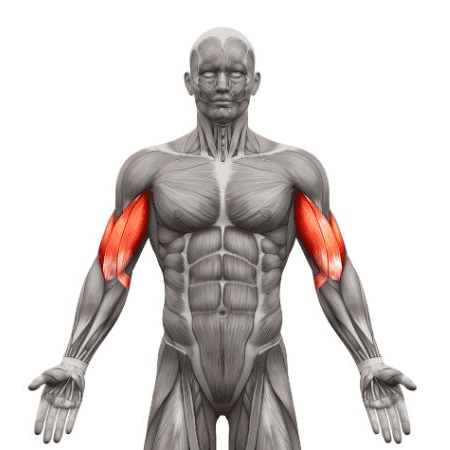
Biceps
Adjust the difficulty of Feet Assisted Ring Pull-up
How to make Feet Assisted Ring Pull-up harder?
How to make Feet Assisted Ring Pull-up easier?
How to make Feet Assisted Ring Pull-up harder?
To make Feet Assisted Ring Pull-up harder:
-
Reduce Foot Contact • Use only your toes or place your feet further away for less assistance.
-
Place Feet on an Elevated Surface • This forces the upper body to do more work, making the movement more challenging.
-
Perform Paused Reps • Hold at the top and mid-position for 2-5 seconds per rep.
-
Perform Slow Eccentrics • Lower yourself as slowly as possible (5-10 seconds) to increase time under tension.
-
Add Weight • Use a weighted vest or hold a dumbbell between your legs to increase resistance.
How to make Feet Assisted Ring Pull-up easier?
To make Feet Assisted Ring Pull-up easier:
-
Increase Foot Contact with the Ground • Keep your feet flat for maximum assistance.
-
Perform Only Negative Reps • Focus on lowering yourself slowly, skipping the pull-up phase.
-
Use a Higher Ring Position • Set the rings higher so you can push with your legs more effectively.
-
Use a Resistance Band for Additional Assistance • Loop a resistance band around the rings and place a foot inside for extra support.
-
Adjust the Tempo • Start with faster reps, then slow them down as you gain strength.

